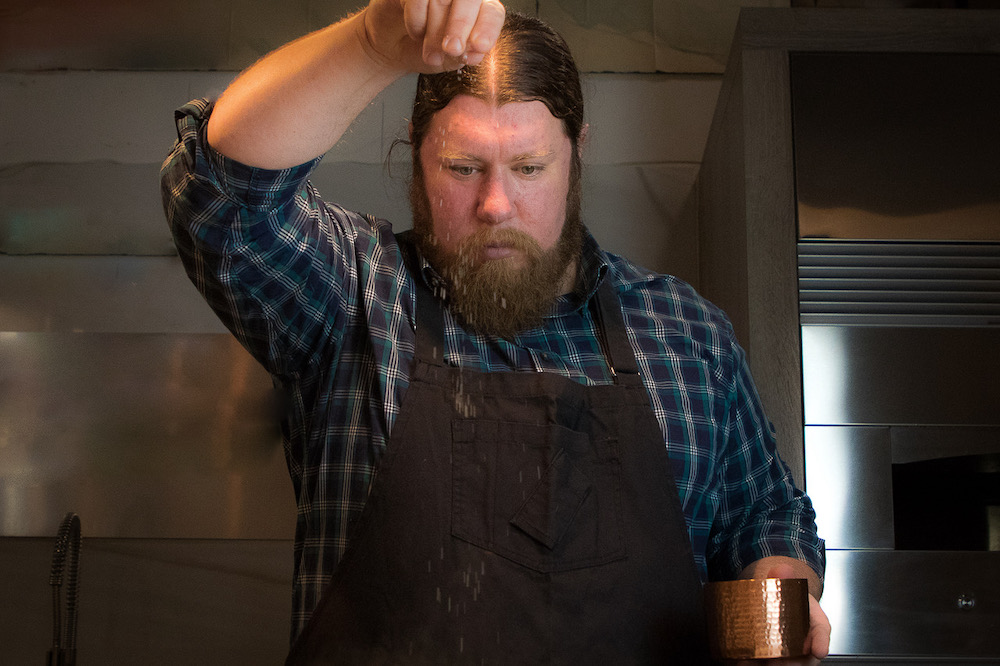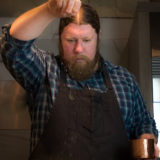

As Patrick Hallahan calls up SPIN, the My Morning Jacket drummer is gearing up for a full-blown blizzard — 12 to 18 inches of snow are expected in his current home of Louisville, Kentucky within 24 hours. And where many Americans would devolve into a panic after a day without takeout, this dude’s prepared — with a fully stocked kitchen and the culinary skills to make good use of it.
But one core message from his new cooking show, In the Kitchen With Patrick Hallahan, is that interesting dishes (and, by association, memories) are tucked away in our cupboards and rarely visited fridge drawers. We just have to seek them out — and, for the novices among us, embrace the unknown.
“The biggest lesson to learn in life really is to push past the fear and challenge yourself to do something you don’t know how to do,” he says. “I could go probably into anybody’s house right now and point out two meals that they could make out of what they have around, but they might not see the connection there. Instead of putting it off, get your hands in there and have some fun with it.”
Hallahan admits upfront he’s “no chef” — he even mispronounces some food-related words in the series’ first episode. But the art of cuisine — and the joy of sharing it with others — is the biggest non-musical through-line of his life. He grew up savoring late ’80s cooking shows (including TLC’s The Urban Peasant) with his family; he’s overseen the food at My Morning Jacket’s One Big Holiday festivals, and he co-founded the Louisville restaurant Butchertown Grocery.
When his band began a lengthy hiatus in 2015, he delved even deeper into this other passion — even telling Relix that he batted around the idea of writing a cookbook. But when the pandemic became a reality, literally hours after My Morning Jacket finished recording a new LP, he decided to fill his suddenly cleared schedule with a different kind of food project.
The three-episode In the Kitchen — premiering Feb. 21 via Seated — features Hallahan’s recipes and stories, weaving in guest spots from his daughter, Jacket bassist Tom Blankenship and VHS or Beta’s Craig Pfunder.
Hallahan spoke to SPIN about the show’s themes and the connection between food and music. While we had him, we also asked for his impressions of famous food-related songs.
SPIN: Tell me about the origins of In the Kitchen.
Patrick Hallahan: It was after I finally stopped mourning my life coming to a screeching halt: not traveling, not playing music in front of people, not seeing friends. It was a bit like mourning a death or something. I went through all kinds of periods of anger and sadness and depression, trying to make sense of a world with no order. Once I got over my freakout, I just decided I was going to take this forced downtime to do some things I’ve been wanting to do for years. But a cooking show was not one of them.
My management was kicking off ideas of things I could do in my downtime: “Would you want to give a drum lesson or something like that?” I don’t know how to do that because I never took a lesson. I’d just go, “Here are some records; go listen to them and come back when you can play like that.” They also said, “You could do a cooking show,” and I was like, “Oh, my God, that sounds like a lot of fun.” I felt like it would be a way to connect with people.
Your show touches on the communal aspects of cooking, and that’s important for those of us lucky enough to quarantine with other people.
The olfactory sense is such a memory trigger — this is a great opportunity for people to get together in the kitchen and make some memories. Why not capitalize on the time we all have together? Or if you’re quarantining by yourself, learn some techniques you can use when people can get back together again and have dinner parties. Because times are so complex right now, it’s hard to give one overarching message from the show, but [one of them] is enjoying the little things in life, like the sound of onions sizzling in olive oil or the smell of butter browning in a pan. There are so many senses we look past because we’re staring at screens. Cooking really makes you focus on the basic elements of life.
Let’s talk about some food-related songs. I’m going to throw some titles at you, and you give me your instant impressions. Let’s start with “Weird” Al’s “Eat It.”
I was a massive “Weird” Al fan when I was a kid, and I wore that tape out. I think I bought two copies of that. That has a soft spot in my heart.
Herbie Hancock’s “Watermelon Man”?
Love it. I love all things Herbie Hancock. He’s a wizard.
Led Zeppelin’s “Custard Pie”?
Yes! Yes, yes, yes. My love for them [is huge]. That’s not a very rare thing. I would say nine out of 10 people are Zeppelin fans.
The Flaming Lips’ “She Don’t Use Jelly”?
Oh, of course. That was my intro to the Flaming Lips — and a lot of people’s intro to the Flaming Lips. That was their first hit. Oh, wow. I remember hearing that song and being like, “What the hell is this?” It started me on a long path that I’m still on. I love that band so much.
I remember seeing them play that song on Letterman when I was a kid. It completely changed my perception of music.
Artists being artists — that’s what you saw. You’re like, “Whoa, you can be weird and melodic and perfect at the same time? How did this happen?” They have a beautiful balance, that band.
The Presidents of the United States of America’s “Peaches”?
I really loved that album when it came out. I bet it still stands up. I haven’t heard it in a long time. It also had “Lump” on it. They were fun!
Here’s a polarizing one: Frank Zappa’s “Watermelon in Easter Hay.”
That is definitely a polarizing [artist]. [Laughs.] I don’t even know that song. I respect the living daylights out of Zappa and his band of merry men and women. They’re pioneer astronaut crazy people. I just don’t ever sit down and pick it apart — perhaps that’s one thing I need to do before this whole world opens back up: become a full-fledged Zappa fan.
The Beach Boys’ “Vegetables”?
That one slipped through my fingers, unfortunately.
System of a Down’s “Chop Suey”?
I remember Toxicity coming out. My friend taped the album for me, and I used to listen to it in my truck all the time. I don’t have track names memorized, but I really liked that album when it came out.
Smashing Pumpkins’ “Mayonaise”?
Oh, absolutely. That album changed my life — the whole damn thing.
Have you ever eaten a meal that inspired you creatively?
Not on a literal level. But some of my favorite band memories are making albums in remote places where we had to cook meals together every night. It wasn’t just the food that inspired music — but with food comes camaraderie. I’d say the social aspects of eating are as important as the nutritional aspects. There have been a lot of beautiful moments making albums where a non-musical bonding moment got us in the mood to think as a unit. It might not be as literal as, “I just ate a piece of corn, so now I’m going to write a song about corn stalks.” But gathering the band around a table and talking about life for a little while and building those memories to draw back from — that feeds into the machine.
I love the idea of being inspired by eating a piece of corn: “Oh, shit — guys, put down the forks. We have to get in the studio.”
[Laughs.] Don’t take another bite! I’ve got an idea. Call the Grammy board — tell them to start making the trophies now.
That’s the next album: The Corn.
The Kernel.
Last year, My Morning Jacket finally released The Waterfall II, the long-awaited sequel to 2015’s The Waterfall. Was it a relief to finally put that out into the world?
We as a band have a hive mind — we really move through things as a unit very seamlessly. One of the few things we contest each other on is what makes it on the album and in what order. To be honest, I lost the battle with some of the songs on Waterfall II. [Laughs.] I was afraid they would never see the light of day or that I’d never get to play them again. That’s the thing with making an album: It’s really unnatural to experience it because you dump your heart and soul into this moment — then it goes into mixing and mastering, and you’re picking it apart for days. For it to then go into a vault for fix or six years — with some of those songs, I was like, “If I never get to play that, I’m gonna be so pissed.”
We had the initial idea of, “We’ll release the second one a year from the first release.” But we started going back and listening to it, and at that time it didn’t feel like a complete project. We would have shoved a group of songs out into the universe without any form around it. When we listened to it this time, in the context of everything going on, with it bringing up good memories of making that album in Stinson Beach [north of San Francisco] — cooking meals and walking on the beach and living together as a unit — it was right. When you put so much into something and you don’t get to see it to fruition, a piece of you is unsettled and incomplete. When that was released, I breathed a sigh of relief. It was a little gift to ourselves that we left unknowingly.
Let’s talk about that other new album.
We recorded the album, hit the last downbeat, and I hopped on a plane to fly home for my wife’s 40th birthday on March 12 of last year — literally slid into home before the light went off in the stadium. That album’s been mixed and mastered, and we’ll release it when we can tour behind it. We’ll have two albums worth of new material to play live that most people haven’t heard before. Who knows what the shows will be like? I’m not gonna paint us into a corner and say we’re gonna play a 14-hour set, but…we could. [Laughs.] My bandmates are gonna shoot me — I’m sorry, guys! I’m sorry!
How would you describe the album sonically?
It’s hard for me to answer because I’m so close to it, but it was recorded by us. There was no producer this time other than Jim — and no engineer. The five of us just worked it out together with no outside interference. We’d just come out of a hiatus, and we were trying to figure out what it meant to be a band again. That’s what it sounds like. It was nothing like we’ve ever done before, and it was a lot of fun.


Leave a comment